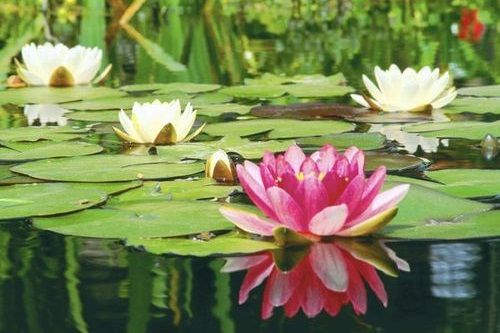The Cultivation of Aquatic Plants - What You Need to Know
When raising aquatic plants in outdoor ponds, it is important to consider the amount of light available, the depth of the pond, the kind of soil, and various other factors. Since most aquatic plants obtain nourishment from the soil, it is necessary to have a soil rich in organic matter. In most natural ponds the accumulation of humus at the bottom is excellent for plant growth. In some ponds, however, the bottom consists largely of sand or gravel that must be covered with a thick layer of rich soil. If the pond is very large, it is often easier to root the plants in earth-filled boxes or pots than to place a thick layer of soil over the entire bottom of the pond.

Most aquatic plants require large amounts of light and should not be grown in shaded areas. In some regions, it is also important to protect the plants from strong winds by growing shrubbery or other windbreaks near the edge of the pond. The depth of the water should be determined by the size of the plants. In many cases, a depth of 2 feet (61 cm) is adequate for most water lilies and other ornamentals.
The choice of plants to be grown depends largely on the size of the pond and the purpose for growing the plants. If fish are to be raised in the pond, it is necessary to grow plants that give off large amounts of oxygen into the water. Among the best known of these so-called oxygenators are arrowheads, eelgrass, and elodea. When aquatic plants are raised for ornament, it is sometimes useful to include some underwater plants that will conceal any boxes, pots, or other unsightly fixtures. Mare's tail and eelgrass are sometimes grown for this purpose.
Another consideration in selecting plants is their rate of growth. Some aquatic plants grow rapidly and form dense masses that hinder the flow of water and clog waterways. One of the most common of these plants is the water hyacinth, a serious pest in parts of the southern United States. It is generally controlled by dragging the water to remove the plants or by destroying them with chemical weed killers.

Most aquatic plants require large amounts of light and should not be grown in shaded areas. In some regions, it is also important to protect the plants from strong winds by growing shrubbery or other windbreaks near the edge of the pond. The depth of the water should be determined by the size of the plants. In many cases, a depth of 2 feet (61 cm) is adequate for most water lilies and other ornamentals.
The choice of plants to be grown depends largely on the size of the pond and the purpose for growing the plants. If fish are to be raised in the pond, it is necessary to grow plants that give off large amounts of oxygen into the water. Among the best known of these so-called oxygenators are arrowheads, eelgrass, and elodea. When aquatic plants are raised for ornament, it is sometimes useful to include some underwater plants that will conceal any boxes, pots, or other unsightly fixtures. Mare's tail and eelgrass are sometimes grown for this purpose.
Another consideration in selecting plants is their rate of growth. Some aquatic plants grow rapidly and form dense masses that hinder the flow of water and clog waterways. One of the most common of these plants is the water hyacinth, a serious pest in parts of the southern United States. It is generally controlled by dragging the water to remove the plants or by destroying them with chemical weed killers.

Comments
Post a Comment